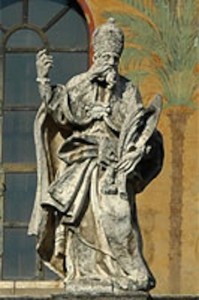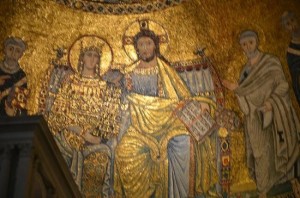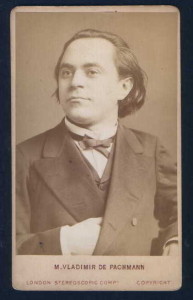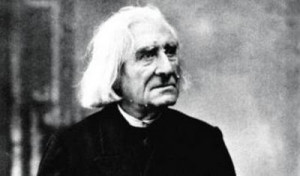Each time you approach Piazza Santa Maria in Trastevere, Roma, its sultry light, shadows, pontifically gesturing statues and earthen tones strike you differently. All change according to mood: yours and its.
The basilica gained a new portico in 1702 when architect Carlo Fontana studded the entrance walls with stele bearing ancient inscriptions. Above the entrance’s balustrade are four figures rudely frozen by a sculptor during the dance of their oration: Saints Callisto, Cornelio, Giulio, and Calepodio, attracting attention of all flocking through their piazza.
Stepping inside for the first time a mosaic from the Byzantine era confirms your suspicion of having left Rome’s baroque façade for another existence, one no longer capable of imposing any chronological disparity. Our tendency to believe in a myth of progress is dispelled as time flows here as a presence uniting images and forms covering half a millennia.
Pietro Cavallini, a contemporary of Giotto’s, avoided the style that his Tuscan based colleague would develop by lessening an unnatural divinity in his subjects’ representation through gestures and spatial perspective. Cavallini’s Christ captures a late Byzantine expression that implicates mystical transcendence.
I first arrived in Roma armed with a folio of blank music paper to fill with new compositions during the summer of 1979. It lay untouched as the piazza drew me into its fold and one day, a spontaneous music overcame me at 6:15 pm as nearby bells became unchained and found me rushing down from the attic on via della Cisterna to a full immersion into their sound. A forceful insistent rhythm excited a layer of overtones that embraced every square inch of the entire piazza’s acoustic space, etching itself into body and being. I sought to arrive daily at that hour as a purification rite and returned a year later armed with a cassette recorder to capture a force that my musical sketches hadn’t a chance in Hell of approaching.
Following three cycles, a single melancholy tone dissipated the accumulated din, to emerge as a fading tender nothingness, soothing in its ebb. An entranced state switched as one’s consciousness was dragged into an undesired reality.
On a return visit in 2011 one crucial bell was missing: the former celestial havoc was now reduced to a cheapened impotence. After searching for the cassette recording, it turned up on a few leftover minutes following a 1980 visit I taped with the 79-year-old pianist Aldo Mantia who described significant secrets about his teacher Vladimir de Pachmann that he discovered in the 1920s.
Other sounds unique to Roma caught Franz Liszt’s ear.
Liszt experienced the city by living in its center, atop Monte Mario, and in Tivoli at the Villa d’Este. Aside from courting the Vatican to obtain a divorce for his mistress, he heard the zampognari (bagpipers) who annually descended at Christmas from their mountain towns, walking all the way into Roma’s historic center, playing novenas and holiday airs.
Liszt was so taken by the music that he orchestrated selections into his Christus Oratorio, a work considered by Busoni to have been Liszt’s masterpiece (so claimed his pupil Edward Weiss in a conversation we once had).
Soon after Liszt’s passing in 1886, a pre-mic recording horn captured the festive music in a 1916 studio session by unnamed performers who play a Pastorale. One imagines that they very well could have been in their thirties or older at the time of the recording and had learned this musical tradition from their shepherd fathers. The striking resemblance may very well represent the playing that attracted Liszt. But take it with a grain of salt: miracles often risk being unmasked as mirages.
–Allan Evans ©2013







